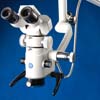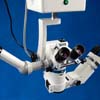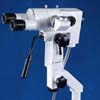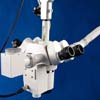ART.II.-Choroiditis with Suppuration
Suppurative choroiditis is anatomically characterized by the products of inflammation, which are deposited between the choroid and retina, or in the vitreous body.Thus we see even with the naked eye a yellowish reflection behind the pupil, which comes from the altered vitreous body or separated retina.
Simultaneously the eye becomes hard, the pupil dilated and immobile. The lens and iris are paused forward towards the cornea. Generally the morbid process is rapidly communicated to the anterior parts of the eye, where we findsymptoms of purulent iritis with hypopyon, and even purulent infiltration of the cornea, which infiltration may more or less rapidly cause the destruction of the membrane. In the worst forms of the disease, we find from the very beginning a well developed chemosis of the ocular conjuctiva, which surrounds and hides the cornea with its livid swelling, and may even project beyond the palpebral fissure.
The eyelids are red and swollen, especially the upper eyelid, which falls down over the inferior lid. The cellular tissue of the orbit becomes the seat of inflammatory infiltration, which determines the protrusion of the eyeball and render it immobile.
Besides a burning pain in the lids and in the entire region, increase by the slightest movement or touch, the patients complain of a deep-seated pain in the eye itself. With a feeling of distention and pulsation, and in the orbit they experience a pain which extends towards the occiput and throughout one side of the face and head.
Inflammatory fever, often intense, then accompanies the disease.
Vision is entirely destroyed.
It should, however, be observed that the inflammatory symptoms are far from being of the same intensity in every case. General disturbance is sometimes very feeble and may be entirely absent, the lids and the conjunctiva being scarcely at all injected; the eyeball, only slightly tender and prominent, preserving its mobility; and the pain, which is not severe, being only felt periodically. Notwithstanding the insignificance of the inflammatory symptoms, the formation of pus on the choroidal surface, in the vitreous body and in the anterior chamber, is in these cases very rapid and abundant.
Progress and Termination.- as a rule, very acute suppurative choroiditis rapidly attains its maximum; rarely it takes several weeks, involving one after the other all the structures of the eyeball (phlegmon of the eye). Sometimes the inflammation then subsides, and the ball imperceptibly atrophies. More commonly the suppuration is prolonged till it produse rupture of the eye, either through the cornea or distended sclerotic. The purulent matters, and frequently part of the contents of the eye, escape, and from the moment the severe pain and inflammatory symptoms decrease and in time disappear. Suppuration also after a short time ceases, and the eyeball atrophies.
Sometimes the perforation becomes reclosed, the purulent products reaccumulate in the interior of the eye, the increased tension of the ball and the pain reappear, and only cease when a fresh perforation allows the pus to escape freely from the eye. In any case the ultimate termination is an atrophic stump.
The atrophic stump, irregular in form, is about the size of a hazelnut. It is sunk deeply in the orbit, which, in young persons, may become contracted after the atrophy of the eyeball. The lids, having lost their normal support, become closed and retracted into the orbit.
The interior of the stump contains remains of the choroid and disorganized retina, fibrous tissue mixed with amorphous organic matter, calcareous deposits, and occasionally true osseous formations. The stump is, as a rule, painless, and supports, without the least inconvenience, the wearing of an artificial eye.
In some cases it becomes periodically the seat of inflammation, of intraocular hemorrhage, and even of fresh purulent effusion.
Prognosis.-The loss of the functions of the eye, and even of its form, being the natural sequence of this disease, the prognosis is absolutely bad.
Etiology.- the most frequent causes of choroiditis with suppuration are injuries, such as contusions of the eyeball, wound, burns, the penetration of foreign bodies, operations for cataract, staphyloma, etc. displacement of the lens, which when displaced act as a foreign body, or suppuration of the cornea producing destruction of that membrane, may also be the cause of this disease affecting the system, such as meningitis, typhoid fever, malignant pustule, puerperal fever, pyemia.
Treatment.-If the disease be the result of some irritation, such as a caused by the presence of a foreign body in the eye, dislocated lens, etc., this source of irritation must be removed as soon as possible. If we think is possible to arrest the progress of the affection, we may try an energetic course of mercury, which, however, is of no further use if suppuration once begins.
We must check the inflammatory symptoms, in the early stages, by blood-letting and cold compresses; and relieve the tension of the eye by repeated paracentesis of the anterior chamber.
As soon as suppuration sets in, we must try to lessen the patient’s suffering, and cut short, as far as possible, the duration of the disease. Narcotics and hot compresses, but, first of all, a free incision to give issue to the purulent matters, fulfill these indications. Enucleation of the eye should not be attempted whilts the cellular tissue of the orbit is inflamed, for it has been followed by suppurative meningitis, terminating fatally. This operation or the evisceration of the eyeball is indicated only when the eyeball becomes the seat of a prolonged suppuration which threaten the life of the patient, or when we cannot otherwise remove a foreign body which has penetrated the eye and becomes the cause of a sympathetic affection in the other.
Whilst the disease last, we must remove from the patient every thing which could injure his eye or general health.
We should make him lie down in a dark room, which can be easily aired, and we should order a regimen suited to his state of health.
Back to Resources
call toll-free:  or email
or email

 or email
or email
Categories
Categories
Dental
Dental Microscopes
Dental Microscopes
Ophthalmic
Ophthalmic Microscopes
Ophthalmic Microscopes
Gynecology
Gynecology Colposcopes
Gynecology Colposcopes




